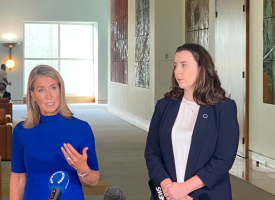Time for a better health deal for rural Australians
AMA Plan for Better Health Care for Regional, Rural, and Remote Australia
The AMA today released its Plan for Better Health Care for Regional, Rural, and Remote Australia, and urged the major parties to adopt its recommendations as part of their rural health policies for the election and beyond.
AMA President, Professor Brian Owler, said that the AMA firmly believes that the standard of health care and access to health care can be lifted in regional, rural, and remote Australia, but it needs significant real funding increases.
“It is essential that government policy and resources are tailored and targeted to cater to the unique nature of rural health care and the diverse needs of rural and remote communities to ensure they receive timely, comprehensive, and quality care,” Professor Owler said.
“The AMA Plan proposes a focus on four key areas - rebuilding country hospital infrastructure; supporting recruitment and retention; encouraging more young doctors to work in rural areas; and supporting rural practices.
“Addressing and investing in these measures will make a long-term difference to the health of Australians living in rural communities.”
The key elements of the AMA Plan are:
Rebuilding country hospital infrastructure
Rural hospitals need modern facilities, and must be able to attract a sustainable health workforce.
They must provide an environment that is conducive to delivering:
- quality care;
- a strong and relevant training experience for doctors in training;
- support the development and maintenance of procedural skills;
- opportunities for professional development; and
- safe working hours.
The Council of Australian Governments (COAG) must consider a dedicated funding stream for rural hospitals, backed by a national benchmark and performance framework, to ensure that State and Territory Governments maintain the level of services that is promised to local communities.
Supporting recruitment and retention
The issue is not just about attracting and retaining an adequate number of doctors to rural areas, it is also about having the right skill mix, including GPs, procedural GPs, other specialists, and medical officers.
The AMA and the Rural Doctors Association of Australia (RDAA) have developed a package of measures that recognises both the isolation of rural and remote practice and the need for the right skill mix in these areas.
The Building a sustainable future for rural practice: the rural rescue package, proposes a two-tier incentive package consisting of:
- a rural isolation payment available to all rural doctors including GPs, locums, other specialists, salaried doctors and registrars, with the level of support provided increasing with rurality; and
- a rural procedural and emergency/on-call loading, aimed at boosting the number of doctors in rural areas with essential advanced skills in a range of areas such as obstetrics, surgical, anaesthetic, acute mental health, or emergency skills.
Encouraging more young doctors to work in rural areas
Recognising that doctors who come from a rural background and/or spend time training in a rural area are more likely to take up long-term practice in a rural location, the AMA has developed a number of positive policy proposals that have the potential to make a real difference for rural patients. These include:
- The establishment of a Community Residency Program – that would support efforts to deliver more training and care in the community, supplement the traditional hospital-based approach to medical training, and promote ‘generalist’ careers.
- An expansion of the Specialist Training Program (STP) to 1,400 places by 2018, with higher priority being given to training places in regional and rural areas, generalist training, and specialities that are under-supplied.
- Changes to medical school selection criteria for Commonwealth-supported students and changes to the structure of courses, such that:
- the targeted intake of medical students from a rural background is lifted from 25 per cent of all new enrolments to one third of all new enrolments; and
- the proportion of medical students required to undertake at least one year of clinical training in a rural area is lifted from 25 per cent to one third.
- The establishment of Regional Training Networks - to bolster rural training opportunities, and to provide a valuable and meaningful career pathway for doctors in training who want to work in regional and rural Australia.
Supporting rural practices
Previous rounds of infrastructure grant funding have a track record of delivering real results for rural communities, with local practices taking realistic steps to improve patient access to services and support teaching activities.
The Australian National Audit Office has also shown that infrastructure funding grants are effective and a good value-for-money investment.
The AMA recommends that the Government fund a further 425 rural GP infrastructure grants of up to $500,000 each that would:
- provide additional infrastructure and space to maintain and increase the level of general practice services provided to local rural and regional communities;
- support teaching and training in general practices, including increasing opportunities for GPs to maintain and increase supervisory skills;
- support opportunities for medical students to experience working in a rural or regional practice; and
- improve the distribution of the health workforce.
Background:
- Regional, rural and remote Australians often struggle to access health services that urban Australians would see as a basic right.
- These inequalities mean that they have lower life expectancy, worse outcomes on leading indicators of health, and poorer access to care compared to people in major cities.
- Death rates in regional, rural, and remote areas are higher than in major cities, and the rates increase in line with degrees of remoteness.
- People living in regional, rural and remote areas are more likely to defer a visit to their general practitioner due to cost.
- They have higher rates of potentially preventable hospitalisations, and are less likely to gain access to aged care.
- Rural communities often find it very difficult to attract and retain doctors, making local access to even basic medical services challenging.
- Rural patients often have to travel significant distances for care, or endure a long wait to see a GP close to where they live.
- Despite Government policy efforts at both Federal and State/Territory level to improve rural health care delivery, this goal is a long way from being achieved.
Key Statistics:
- Most Australians live in major cities (70 per cent), while 18 per cent live in inner regional areas, 9 per cent in outer regional areas, and 1 per cent in both remote and very remote areas.
- Life expectancy is lower for people in regional and remote Australia. Compared with major cities, the life expectancy in regional areas is 1–2 years lower, and in remote areas is up to 7 years lower.
- The age standardised rate of the burden of disease increases with increasing remoteness, with very remote areas experiencing 1.7 times the rate for major cities.
- Coronary heart disease, suicide, COPD, and cancer show a clear trend of greater rates of burden in rural and remote areas.
- The number of medical practitioners, particularly specialists, steadily decreases with increasing rurality. For example, in 2013-14, while the number of full time workload equivalent GPs per 100,000 population in major cities was 102, there were 91 in outer regional areas, 70 in remote areas, and only 57 in very remote areas.
- Rural medical practitioners work longer hours than those in major cities. For example, in 2012, GPs in major cities worked 38 hours per week on average, while those in inner regional areas worked 41 hours, and those in remote/very remote areas worked 46 hours.
- Rural doctors are also getting older. The average age of rural doctors in Australia is nearing 55 years, while the average age of remaining rural GP proceduralists – rural GP anaesthetists, rural GP obstetricians and rural GP surgeons – is approaching 60 years.
- International medical graduates (IMGs) now make up over 40 per cent of the medical workforce in rural and remote areas.
- There is a health care deficit of at least $2.1 billion in rural and remote areas, reflecting chronic underspend of Medicare and the PBS and publicly-provided allied health services.
The AMA Plan for Better Health Care for Regional, Rural, and Remote Australia is at https://ama.com.au/position-statement/plan-better-health-care-regional-rural-and-remote-australia
26 May 2016
CONTACT: Kirsty Waterford 02 6270 5464 / 0427 209 753



